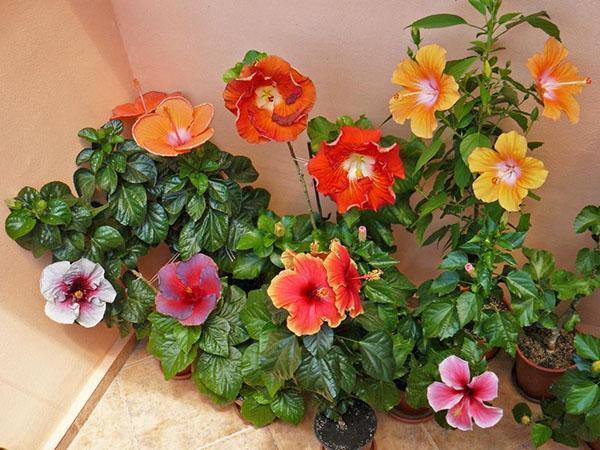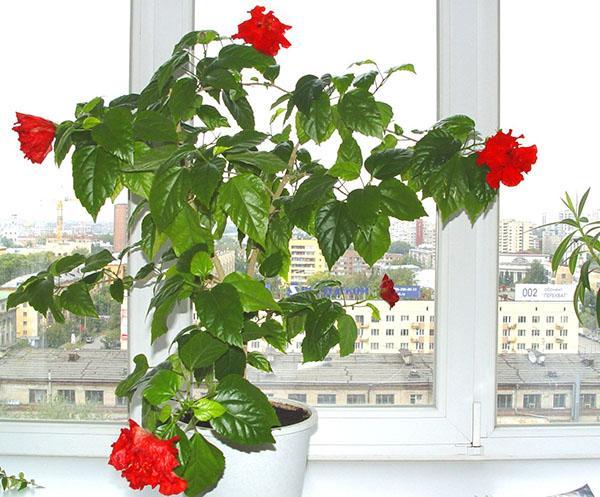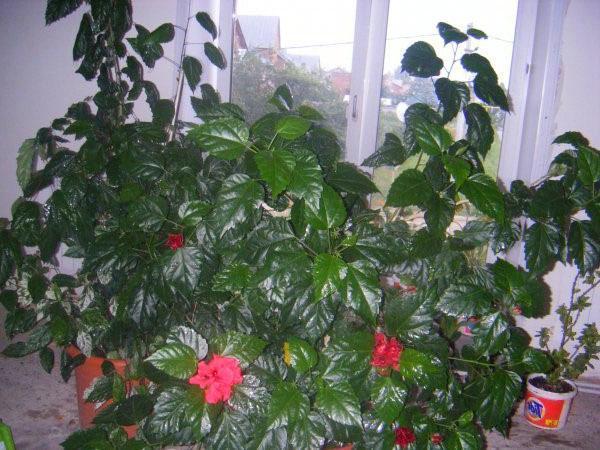What kind of care does a hibiscus need at home?
 Pictured on photo hibiscus, home care requires little, and the positive is tangible. Huge flowers, beautiful leaves - far from all the advantages of a pet. Of the many varieties of hibiscus, only Chinese rose settled in a person's dwelling. We especially love indoor hibiscus in a spacious rural house, installed in the upper room so that a stream of light pours on it from morning to evening.
Pictured on photo hibiscus, home care requires little, and the positive is tangible. Huge flowers, beautiful leaves - far from all the advantages of a pet. Of the many varieties of hibiscus, only Chinese rose settled in a person's dwelling. We especially love indoor hibiscus in a spacious rural house, installed in the upper room so that a stream of light pours on it from morning to evening.
Useful properties of indoor hibiscus

 Infusions of leaves and flowers help to cleanse the skin, the gruel from the leaves is applied to boils and boils. So, a home first aid kit is hidden in a beautiful plant.
Infusions of leaves and flowers help to cleanse the skin, the gruel from the leaves is applied to boils and boils. So, a home first aid kit is hidden in a beautiful plant.
Hibiscus tea, a favorite drink of many, is obtained from hibiscus flowers. It has a beneficial effect on hypertensive patients and helps the stomach cope with heavy food.
Air humidification due to the evaporation of moisture from the topsoil, contemplation of a beautiful flowering bush create healthy air and relieve internal stress. This is evidenced by the hibiscus in the photo.
Home content of the Chinese rose
 Years will pass, several transplants will be required before the flower takes center stage in the composition. In a floor pot, an evergreen tree with dark toothed leaves attracts admiring glances from guests. With good care, the indoor hibiscus flower lives for a long time. He needs a little attention and care:
Years will pass, several transplants will be required before the flower takes center stage in the composition. In a floor pot, an evergreen tree with dark toothed leaves attracts admiring glances from guests. With good care, the indoor hibiscus flower lives for a long time. He needs a little attention and care:
- a certain composition of the earth and a pot for growth;
- well lit place without direct sunlight;
- watering and feeding;
- bush formation;
- protection against diseases and pests.
 In addition, the plant needs to adhere to summer and winter conditions and does not like drafts. A signal that the plant is suffering will be yellowing of the leaves, dropping them and unopened buds.
In addition, the plant needs to adhere to summer and winter conditions and does not like drafts. A signal that the plant is suffering will be yellowing of the leaves, dropping them and unopened buds.
How to care for hibiscus at home, we will analyze in stages from the moment of purchase.
Like many indoor plants, hibiscus does not need a growing pot. When choosing dishes for planting a plant, you need to make sure that there are drainage holes and create a good drainage layer either with traditional materials, or with a special one - Seramis granulate. The use of a special composition will saturate the soil with the necessary micronutrient fertilizers for the indoor hibiscus flower.
The composition of the land for planting is simple:
- clay turf - 2 parts;
- leaf and humus earth - 1 part each;
- sand, charcoal, vermiculite - little by little as additives.
 To transplant or reload the plant at a young age, you need to annually in a larger pot, but only in the spring. A more mature bush is transplanted more often, then the top layer of the earth is changed. When replanting, old dark roots can be trimmed with a clean tool. Light young roots work for plant nutrition.
To transplant or reload the plant at a young age, you need to annually in a larger pot, but only in the spring. A more mature bush is transplanted more often, then the top layer of the earth is changed. When replanting, old dark roots can be trimmed with a clean tool. Light young roots work for plant nutrition.
Lighting plays a major role in the decorative effect of the bush. Hibiscus does not bloom in the shade; in summer and winter, it should stand in the light. If the sun is scorching, indoor hibiscus needs shading. In summer, the temperature of 18-25 degrees is comfortable for a flower.But the hotter, the more often the flower is watered and sprayed. In winter, keeping in cool conditions, but not lower than 12 degrees, will provoke a summer riot of flowers.
Water the plant with soft, settled water without traces of chlorine. It is the wrong watering that is often a provocateur of diseases. Therefore, it is impossible to overdry the plant - it will shed leaves and flowers. The roots will rot from the overflow with the ensuing consequences. From hard, cold and rusty water, the leaves will turn yellow, which is demonstrated by the photo, hibiscus at home with improper care.
The roots will rot from the overflow with the ensuing consequences. From hard, cold and rusty water, the leaves will turn yellow, which is demonstrated by the photo, hibiscus at home with improper care.
For good development, the plant requires frequent feeding during flowering. In the spring, for the development of green mass, the plant needs nitrogen, but not much. Hibiscus needs phosphorus to flourish. And for the good development of the bush it is required potassium... It is better to purchase a ready-made composition of soluble fertilizers for flowering plants.
 For good flowering, indoor hibiscus for home care needs to prune shoots. Flowers are formed only on young twigs. After pruning, the branch gives new shoots, on which flowers are formed.
For good flowering, indoor hibiscus for home care needs to prune shoots. Flowers are formed only on young twigs. After pruning, the branch gives new shoots, on which flowers are formed.
Breeding methods of the Chinese rose
 You can propagate a flower by seeds, cuttings. The easiest way is to get a handle. When the plants are pruned, the tops are used for propagation. Germinate cuttings in water or wet sand in a warm place.
You can propagate a flower by seeds, cuttings. The easiest way is to get a handle. When the plants are pruned, the tops are used for propagation. Germinate cuttings in water or wet sand in a warm place.  The roots that appear are slightly grown and rooted in a permanent place, in a glass up to 10 cm in diameter. With proper care, a new plant will bloom in the same year.
The roots that appear are slightly grown and rooted in a permanent place, in a glass up to 10 cm in diameter. With proper care, a new plant will bloom in the same year.
It is recommended to grow seedlings from seeds in spring. Germination is carried out with bottom heating up to 25-27 degrees. Seedlings dive after the appearance of two true leaves. Young plants will bloom in the third year or later.
Caring for a sick plant
 How to care for hibiscus if it is sick? It is necessary to analyze why the flower sheds leaves or flowers. The first thing to do is to create the right conditions of detention. If the disease has not had time to become chronic, results will be noticeable in two weeks.
How to care for hibiscus if it is sick? It is necessary to analyze why the flower sheds leaves or flowers. The first thing to do is to create the right conditions of detention. If the disease has not had time to become chronic, results will be noticeable in two weeks.
 As a prophylaxis against insect infestation of bushes, you can use a shower for leaves, Water will wash away dust, aphids, and prevent spider mites from organizing a colony. Chemical protective agents are used after traditional cleaning methods.
As a prophylaxis against insect infestation of bushes, you can use a shower for leaves, Water will wash away dust, aphids, and prevent spider mites from organizing a colony. Chemical protective agents are used after traditional cleaning methods.
Let's analyze the main causes and ways to eliminate them:
| Problem | Cause | Solutions |
| Attacked by pests | Weakened plant. | Use protective equipment, transplant into new soil. |
| Bacterial fungal diseases | Cold, damp, dark. | Improve housing conditions, revise the roots with transplantation, treat with fungicides. |
| The leaves turn yellow, the veins are green | Watering with cold, hard, chlorinated water, cold and damp. | Change the conditions of detention, change the soil, add iron vitriol to the irrigation water. Heat the hibiscus. Protect from drafts. |
| No flowers and buds | A lot of nitrogen, in winter the plant did not rest in the cool. | Improve lighting, create conditions for kidney formation, reduce the proportion of nitrogen in fertilizers. |
| Buds and buds fall | The temperature regime and conditions of detention were drastically changed. | Put in a warm place, feed with phosphorus, check for insect pests. You cannot turn the pot and change its place during flowering. |
Such are the simple reasons for the malaise of indoor hibiscus.